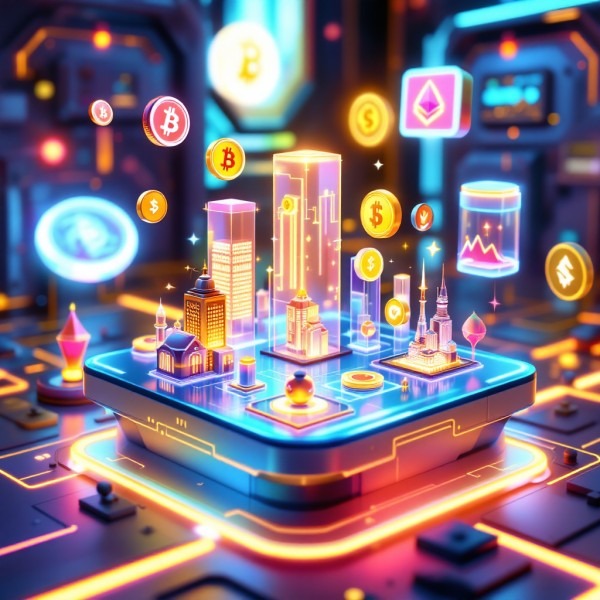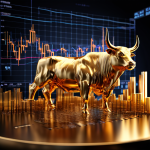Understanding Digital Assets: The Vanguard of the Digital Revolution
January 08, 2025
Introduction: Grasping the Essence of Digital Wealth
In the relentless surge of the digital age, digital assets stand as the new frontier of wealth and innovation. These non-physical treasures transcend traditional boundaries, embodying value in myriad forms—from cryptographic tokens and virtual goods to digital media and intellectual property. As the backbone of the modern economy, digital assets offer unparalleled opportunities and challenges, reshaping how we perceive ownership, value, and investment. To navigate this dynamic landscape, one must delve deep into the core of digital assets, understanding their multifaceted nature and the forces driving their evolution.
Cryptocurrency: The Vanguard of Digital Assets
At the forefront of digital assets lies cryptocurrency, the revolutionary force that has disrupted conventional finance. Icons like Bitcoin and Ethereum have redefined money and introduced decentralized systems that challenge centralized authorities. Bitcoin, often dubbed “digital gold,” serves as a store of value, while Ethereum’s smart contracts enable programmable transactions, fostering an ecosystem of decentralized applications (dApps).
The true power of cryptocurrencies lies in their decentralization and blockchain technology. Blockchain ensures transparency, security, and immutability, making transactions tamper-proof and fostering trust in an era where trust is often elusive. This technological prowess attracts institutional investors and tech enthusiasts, driving mass adoption and innovation. However, the volatile nature of cryptocurrencies, influenced by market sentiment and regulatory developments, demands strategic foresight and resilience from investors.
Digital Media: A Wealth of Possibilities
Digital media represents a cornerstone of the digital asset ecosystem, transforming how we create, consume, and share content. From stunning digital images and immersive videos to captivating music and interactive ebooks, digital media has revolutionized artistic expression and information dissemination. Platforms like YouTube, Spotify, and digital publishing houses have democratized content creation, allowing creators to reach global audiences with unprecedented ease.
Moreover, the rise of Non-Fungible Tokens (NFTs) has catapulted digital media into a new era of ownership and monetization. NFTs provide verifiable ownership of unique digital items, from artwork to virtual real estate, leveraging blockchain to ensure authenticity and scarcity. This innovation empowers artists and creators to monetize their work directly and introduces new investment avenues for collectors and enthusiasts, blending creativity with financial opportunity.
Software: The Digital Building Blocks
In digital assets, software serves as the essential infrastructure powering the digital economy. Operating systems like Windows and macOS, alongside ubiquitous applications like Microsoft Office and Adobe Creative Cloud, are indispensable tools that drive productivity and innovation. Often licensed digitally, these software assets underscore the shift from physical to intangible resources in modern business operations.
The advent of open-source software has further accelerated this transformation, fostering collaboration and innovation across global communities. Platforms like GitHub enable developers to contribute to and build upon existing projects, creating a vibrant ecosystem of shared knowledge and technological advancement. This collaborative spirit not only enhances software quality and security but also democratizes access to cutting-edge tools, empowering individuals and businesses to harness the full potential of digital assets.
Intellectual Property: Protecting Creativity
Intellectual Property (IP) is a crucial pillar in the digital asset landscape, safeguarding the creativity and innovation that drive economic and cultural growth. Digital IP encompasses a broad spectrum of assets, including patents, copyrights, trademarks, and domain names, each playing a vital role in protecting ideas, creations, and brand identities.
In the digital era, IP protection has evolved to address the unique challenges of online environments. Digital patents secure groundbreaking inventions, enabling innovators to commercialize their creations without fear of infringement. Copyrighted works, from digital art to software code, ensure creators retain control over their intellectual output, fostering a fair and competitive market. Trademarks and domain names protect brand identities in the vast digital marketplace, preventing unauthorized use and ensuring consumer trust.
The tokenization of IP through blockchain technology has further enhanced its protection and monetization. By digitizing IP assets, creators can leverage smart contracts to automate licensing and royalty payments, streamlining the commercialization process and maximizing revenue potential.
Virtual Goods and Collectibles: Digital Ownership Redefined
The surge of virtual goods and collectables has added a thrilling dimension to the digital asset ecosystem, blending creativity, technology, and commerce in unprecedented ways. These assets, often intertwined with online gaming and virtual environments, offer unique ownership experiences through Non-Fungible Tokens (NFTs). NFTs have revolutionized how we perceive and trade digital items, from virtual real estate in the metaverse to exclusive in-game assets and digital art collectables.
NFTs ensure the uniqueness and provenance of digital goods, allowing creators to monetize their work while providing collectors with verifiable ownership. This innovation has spawned vibrant marketplaces where digital treasures are bought, sold, and traded, fostering a dynamic economy of digital ownership. The metaverse, a sprawling digital universe where users interact and engage, leverages NFTs to create immersive experiences and economies, pushing the boundaries of what digital assets can achieve.
Real-World Assets Tokenized Digitally
The tokenization of real-world assets bridges the gap between the physical and digital realms, unlocking new possibilities for investment and ownership. By converting tangible assets like real estate, art, and commodities into digital tokens on a blockchain, tokenization enhances liquidity, enables fractional ownership, and reduces administrative overhead.
Real estate tokenization allows investors to buy property shares, diversifying their portfolios without substantial capital. Art tokenization democratizes access to high-value artworks, enabling fractional ownership and expanding the market beyond traditional galleries. Similarly, tokenizing commodities like gold introduces new investment vehicles that combine physical asset stability with digital flexibility.
This convergence of physical and digital assets broadens investment opportunities and fosters a more inclusive and efficient market, where ownership is accessible to a wider audience, and transactions are streamlined through blockchain technology.
The Intersection of Finance and Digital Assets
The intersection of finance and digital assets is a nexus of innovation, transforming traditional financial systems and introducing new paradigms of wealth management. Decentralized Finance (DeFi), a subset of digital assets, leverages blockchain technology to create an open and permissionless financial ecosystem. DeFi platforms enable peer-to-peer lending, borrowing, and trading without intermediaries, democratizing access to financial services and reducing costs.
Digital asset management platforms have emerged to cater to the growing demand for secure storage, trading, and investment in digital assets. These platforms provide comprehensive solutions for managing diverse portfolios, integrating advanced tools like algorithmic trading, real-time analytics, and automated rebalancing to optimize investment strategies.
Moreover, traditional financial institutions increasingly embrace digital assets, integrating them into their operations and offering new financial products. Banks, investment firms, and hedge funds are recognizing the potential of digital assets to enhance their offerings, drive innovation, and meet the evolving needs of their clients.
Digital Assets in the Age of Web 3.0
As we venture deeper into the era of Web 3.0, digital assets are poised to play a pivotal role in shaping the next generation of the internet. Web 3.0 envisions a decentralized, user-centric internet where digital assets and blockchain technology underpin new forms of interaction, ownership, and economic activity.
Decentralized Finance (DeFi) continues to expand, creating a new financial ecosystem that operates independently of traditional institutions. Tokenization of Everything (ToE) envisions digitising various real-world and digital resources, making them tradable on blockchain-based platforms. This innovation promises to revolutionize ownership, investment, and access to a wide range of assets, enhancing liquidity and democratizing access.
The Metaverse, a fully immersive digital universe where users interact and engage in virtual environments, leverages digital assets to create thriving economies and social dynamics. NFTs enable ownership of virtual land, items, and experiences, fostering new digital interaction and commerce forms. This convergence of digital assets and virtual reality opens up limitless possibilities for creativity, expression, and economic opportunity.
Challenges and Considerations
While the digital asset landscape is brimming with potential, it has challenges. Navigating this complex ecosystem requires awareness of the following key considerations:
- Regulatory Uncertainty: The regulatory environment for digital assets remains fluid, with varying approaches across different jurisdictions. Regulatory changes can significantly impact market dynamics, investor confidence, and the adoption of digital assets. Staying informed and compliant with evolving regulations is crucial for long-term success.
- Security: Ensuring the security of digital assets is paramount. The rise of digital assets has also led to an increase in cyber threats, including hacks, fraud, and scams. Robust security measures, such as multi-factor authentication, cold storage, and regular security audits, are essential to protect investments and maintain trust.
- Market Volatility: Digital asset markets are notoriously volatile, with prices subject to rapid fluctuations driven by market sentiment, technological advancements, and macroeconomic factors. This volatility presents both opportunities and risks, requiring investors to adopt strategies that balance potential returns with risk management.
- User Education: Many individuals remain unfamiliar with digital assets and their potential. Comprehensive education and awareness initiatives are essential to ensure safe and informed participation in the digital asset space. Empowering users with knowledge fosters responsible investing and mitigates the risks associated with misinformation and misunderstanding.
- Technological Advancements: The rapid pace of technological innovation in blockchain and digital assets necessitates continuous learning and adaptation. Staying abreast of the latest developments, tools, and platforms is critical for leveraging the full potential of digital assets and maintaining a competitive edge.
The Future of Digital Assets: A New Paradigm of Value
The journey through the realm of digital assets reveals an ever-evolving landscape marked by innovation, disruption, and limitless possibilities. As technology advances, digital assets will become increasingly integrated into our daily lives, transforming how we interact with value, ownership, and commerce.
The surge of digital assets represents a transformative shift in the global economy, where intangible resources hold tangible power. From decentralized finance and tokenized real-world assets to the burgeoning NFT market and the immersive metaverse, digital assets are redefining the very fabric of our economic and social structures.
As industries and individuals adapt to this digital revolution, the ability to understand, harness, and innovate with digital assets will be a defining factor in shaping the future. Whether you are an investor seeking new opportunities, a creator looking to monetize your work, or an entrepreneur building the next big platform, digital assets offer a wealth of possibilities waiting to be unlocked.
We move toward a more inclusive, efficient, and dynamic economic system in embracing this new paradigm. Digital assets are not just a fleeting trend; they are the cornerstone of the digital future, offering unprecedented avenues for growth, innovation, and value creation. The horizon is vast, and the journey has only just begun. Prepare to navigate the digital frontier with courage, strategy, and an unwavering commitment to harnessing the power of digital assets.













